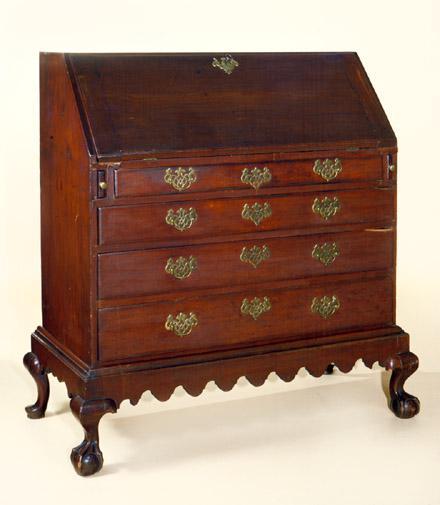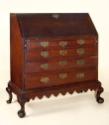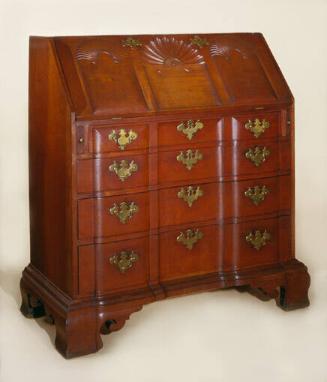Slant-front Desk
Original OwnerProbably originally owned by
Luther Stocking
(American, 1751 - 1831)
Furniture MakerMade by
Unknown
Date1780-1795
MediumCherry primary wood, tulip poplar, eastern white pine and maple secondary wood, brass and leather hardware
DimensionsPrimary Dimensions (overall height x width x depth): 43 15/16 x 42 5/16 x 21 1/2in. (111.6 x 107.5 x 54.6cm)
ClassificationsFurniture
Credit LineGift of Frederick K. and Margaret R. Barbour
Object number1960.7.7
DescriptionCherry slant-front desk in the Chippendale, or rococo, style. The slant-front desk has local characteristics associated with the Wethersfield style, specifically the Stocking group. The desk has a flat top and slant front over four graduated drawers. The top drawer is slightly narrower than the others and is flanked by a loper, or thin board that pulls out to form a support for the slant front when open. The desk fits inside base molding above the front and side skirts. The front skirt has seven cyma curves, or S-curves, flanked by a spur and a raised half circle; there are small horizontals between each curve on the front skirt. Each side skirt has a cyma curve and a reverse cyma curve flanked by a spur and a raised half circle. The cabriole legs on the front terminate in claw-and-ball feet; those on the back terminate in pad feet.
The interior arrangement of the desk consists of a central prospect door flanked by an applied vertical spindle, then four pigeonholes over a drawer, over two drawers side-by-side. The prospect door has a recessed, wedge-shaped, carved shell with eight projecting rays and a scalloped top edge. The door has leather hinges; it opens to a compartment with two pigeonholes over a single drawer. At the top of each pigeonhole is a valance with a lower edge shaped with a cyma curve and reverse cyma curve; this pair is flanked by a small horizontal and a hanging quarter circle. The valances on the pigeonholes behind the prospect door form the front of a single shallow drawer. After removing this drawer and pressing a concealed spring at the top of the prospect, the entire prospect door and its flanking spindles can be removed. This reveals additional hidden compartments: a tall, shallow drawer is concealed behind each spindle; and three square-shaped, removeable compartments are concealed in a well below a panel of wood at the back of the prospect casing. Hardware on the desk includes a pierced brass lock escutcheon at the top center edge of the slant front, and a pair of hinges at the bottom. Each graduated drawer has a pierced brass lock escutcheon in the center flanked by a pierced brass escutcheon with a bail pull; the lock escutcheon on the bottom drawer is blind. Each loper and interior desk drawer has a small brass knob. The prospect door opens on leather hinges. It has a small brass knob at the base of the shell, and a keyhole and locking mechanism at the left edge.
Condition: The secret compartments behind the turned spindles are missing their small leather pulls. There are insect holes in the maple portions of the frame. The drawer runners are well worn. The hardware appears to be original.
Design and Construction Details:
Case Construction. The top is dovetailed to the case sides. The backboards are horizontally oriented and are nailed into rabbets in the case sides. The desk sits in a frame consisting of a rail tenoned into each leg post and secured with wooden pins. The desk rests on the rails and leg posts, while the front and side skirts are nailed to the rails. The knee returns are rounded and are applied to the front of the front and side skirts. The two claw-and-ball feet have round, undefined knuckles on the toes and a tall ball. The pad feet are in the Wethersfield style, with a bowl-shaped circular foot resting on a truncated cone. The well that stores the desk's secret compartments rests on a wooden support that runs across the width of the desk, behind the top graduated drawer; this support is tenoned into the case sides.
Drawer Construction. The drawer dividers are visibly dovetailed into the case sides. The vertical partitions are visibly dovetailed into the rail above and into the drawer divider below; these extend back the full depth of the case. The top drawer runners are tenoned into the drawer divider in front and into the well support in back. The drawer runners for the full-width exterior drawers are nailed to the case sides. The exterior drawer fronts are lip-molded and have ovolo, or thumbnail, molding on all four sides. The tops of the drawer sides are curved. The drawer bottom slides into grooves in the front and sides of each drawer and is nailed at the back. The interior drawer bottoms fit into rabbets on the front and sides of the drawer and are nailed at the back. The dovetail pins are of an average size and angle.
Please see attached essay by Dr. Thomas P. Kugelman for more information about this piece.
NotesOwner Note: Luther Stocking (1751-1831) was appointed Tax Collector in Kensington parish in Wethersfield. According to museum records, a booklet was found in one of the secret compartments that lists the tax roll in long-hand and offers notification of Stocking's appointment as Collector. These are now located in the Connecticut Historical Society Library. (Hudson 2/23/2005)The interior arrangement of the desk consists of a central prospect door flanked by an applied vertical spindle, then four pigeonholes over a drawer, over two drawers side-by-side. The prospect door has a recessed, wedge-shaped, carved shell with eight projecting rays and a scalloped top edge. The door has leather hinges; it opens to a compartment with two pigeonholes over a single drawer. At the top of each pigeonhole is a valance with a lower edge shaped with a cyma curve and reverse cyma curve; this pair is flanked by a small horizontal and a hanging quarter circle. The valances on the pigeonholes behind the prospect door form the front of a single shallow drawer. After removing this drawer and pressing a concealed spring at the top of the prospect, the entire prospect door and its flanking spindles can be removed. This reveals additional hidden compartments: a tall, shallow drawer is concealed behind each spindle; and three square-shaped, removeable compartments are concealed in a well below a panel of wood at the back of the prospect casing. Hardware on the desk includes a pierced brass lock escutcheon at the top center edge of the slant front, and a pair of hinges at the bottom. Each graduated drawer has a pierced brass lock escutcheon in the center flanked by a pierced brass escutcheon with a bail pull; the lock escutcheon on the bottom drawer is blind. Each loper and interior desk drawer has a small brass knob. The prospect door opens on leather hinges. It has a small brass knob at the base of the shell, and a keyhole and locking mechanism at the left edge.
Condition: The secret compartments behind the turned spindles are missing their small leather pulls. There are insect holes in the maple portions of the frame. The drawer runners are well worn. The hardware appears to be original.
Design and Construction Details:
Case Construction. The top is dovetailed to the case sides. The backboards are horizontally oriented and are nailed into rabbets in the case sides. The desk sits in a frame consisting of a rail tenoned into each leg post and secured with wooden pins. The desk rests on the rails and leg posts, while the front and side skirts are nailed to the rails. The knee returns are rounded and are applied to the front of the front and side skirts. The two claw-and-ball feet have round, undefined knuckles on the toes and a tall ball. The pad feet are in the Wethersfield style, with a bowl-shaped circular foot resting on a truncated cone. The well that stores the desk's secret compartments rests on a wooden support that runs across the width of the desk, behind the top graduated drawer; this support is tenoned into the case sides.
Drawer Construction. The drawer dividers are visibly dovetailed into the case sides. The vertical partitions are visibly dovetailed into the rail above and into the drawer divider below; these extend back the full depth of the case. The top drawer runners are tenoned into the drawer divider in front and into the well support in back. The drawer runners for the full-width exterior drawers are nailed to the case sides. The exterior drawer fronts are lip-molded and have ovolo, or thumbnail, molding on all four sides. The tops of the drawer sides are curved. The drawer bottom slides into grooves in the front and sides of each drawer and is nailed at the back. The interior drawer bottoms fit into rabbets on the front and sides of the drawer and are nailed at the back. The dovetail pins are of an average size and angle.
Please see attached essay by Dr. Thomas P. Kugelman for more information about this piece.
Status
On view










